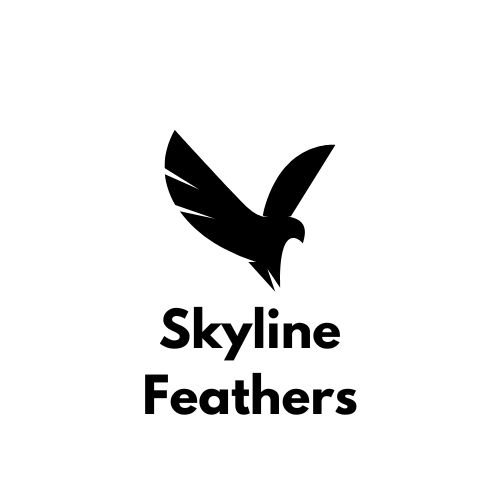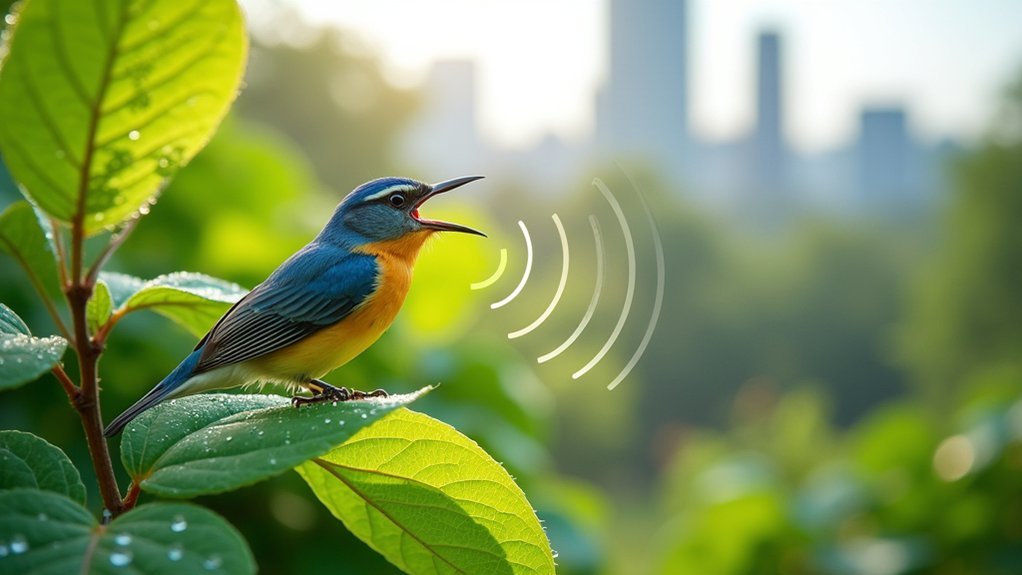Mounting Eastern Bluebird nest boxes at 4-6 feet above ground provides ideal balance between bird accessibility and predator protection. This height range offers easier monitoring while maintaining safety for nesting birds. You’ll achieve higher fledging success rates as research shows predation decreases by over 50% at this elevation. Secure boxes on 1-inch conduit pipes and position entrance holes toward open habitat. The perfect height enhances your chances of attracting bluebirds and supporting successful broods.
Optimal Mounting Height for Eastern Bluebird Boxes

The ideal height for mounting Eastern Bluebird nest boxes falls between 4 to 6 feet above the ground. This height range offers the perfect balance between accessibility for the birds and protection from common predators.
Eastern Bluebird nest boxes thrive at 4-6 feet above ground, providing perfect accessibility for birds while maintaining protection from predators.
When you position nest boxes at this height, bluebirds can easily spot them while searching for nesting sites in open areas.
Using a 1-inch round conduit pipe to mount your nest boxes at this height provides additional stability and helps deter climbing predators.
You’ll also find that nest boxes mounted at 4 to 6 feet are much easier for you to monitor and maintain throughout breeding season.
Remember to place your boxes in open habitats away from dense vegetation, as this further enhances nesting success while maintaining the best mounting height.
Scientific Research Supporting the 4-6 Foot Guideline
Studies comparing bluebird nest boxes at various heights show that those mounted 4-6 feet off the ground consistently yield higher fledging success rates.
You’ll find that predators have more difficulty accessing nests at this elevation, with research documenting considerably lower predation incidents compared to boxes mounted below 4 feet.
This ideal height also aligns with researchers’ observations of natural nesting preferences, where bluebirds instinctively select elevated positions that balance predator avoidance with territorial defense capabilities.
Predation Risk Analysis
While planning your bluebird nest box installation, understanding predation risks becomes essential for maximizing nesting success. Mounting boxes 4-6 feet off the ground creates a significant barrier against common threats. Research shows this height range reduces predation by over 50% compared to boxes placed at just 2 feet.
| Predator Type | Risk at 2′ Height | Risk at 4-6′ Height |
|---|---|---|
| Raccoons | Very High | Moderate |
| Cats | High | Low |
| Snakes | High | Minimal |
| Ground mammals | High | Low |
| Larger birds | Moderate | Moderate |
Adding a predator guard further enhances protection when your box is properly mounted. This strategic height also improves your ability to monitor nesting activity and detect potential threats, ensuring bluebirds can raise their young with minimal interference.
Height Performance Comparisons
Scientific findings consistently validate the 4-6 foot mounting height recommendation through extensive field research spanning decades.
When researchers compared nesting success rates across various mounting heights, boxes positioned within this ideal range demonstrated considerably higher fledging rates and occupancy levels.
You’ll notice measurable differences in bluebird behavior when boxes are properly mounted. At 4-6 feet, bluebirds enjoy better visibility to spot food sources and potential threats while remaining sufficiently elevated from ground predators like raccoons and cats.
This height also strategically reduces competition from house sparrows, which typically prefer lower nesting locations.
The recommendation isn’t arbitrary—it’s derived from careful observation of natural bluebird nesting preferences in the wild and confirmed through documented success rates in controlled studies.
Safety Benefits of Mid-Height Nest Box Placement

Mounting your bluebird boxes at 4-6 feet provides essential protection from ground predators while still allowing you to easily monitor nesting progress without special equipment.
This mid-range height also reduces the threat from aerial predators like crows and hawks that might target boxes placed at higher elevations.
You’ll find that boxes at this height maintain better temperature stability, as they’re high enough to avoid ground-level temperature fluctuations but low enough to benefit from natural shade and wind protection.
Protection From Predators
When placed at a height of 4-6 feet from the ground, bluebird nest boxes offer essential protection against common predators. This strategic mount height creates a significant barrier for ground-based threats like raccoons and cats, which struggle to reach nests at this elevation.
For maximum protection, install your nest boxes on smooth metal poles or conduit pipes, making it challenging for climbing predators to access. Adding baffle guards enhances this defense system against both climbing and aerial threats.
The mid-height placement also gives adult bluebirds better visibility to monitor their surroundings and defend their territory effectively.
Position your boxes in open areas away from dense vegetation to prevent surprise attacks. This combination of proper height, mounting materials, and strategic placement creates the safest possible environment for bluebird families.
Easier Monitoring Access
The safety benefits of mounting bluebird nest boxes at 4-6 feet extend beyond protecting birds to enhancing human monitoring.
At this ideal height, you’ll eliminate the need for ladders or special equipment when checking on nesting progress, reducing your risk of falls and injuries.
You can quickly inspect nest boxes at eye level without straining or overreaching, making regular monitoring a simple task rather than a dangerous chore. This accessibility encourages more frequent checks, allowing you to track nesting success with minimal disturbance.
The mid-height placement also gives you better visibility of the box entrance, making it easier to spot any potential issues before they become serious.
When you can safely and comfortably monitor your nest boxes, you’ll create a more sustainable bluebird conservation effort right in your backyard.
Temperature Regulation Advantages
Because internal temperature stability directly impacts nest success, the 4-6 foot mounting height provides essential thermal benefits for bluebird families. This elevation creates an ideal microclimate that protects eggs and hatchlings from temperature extremes.
| Height Benefit | Temperature Effect |
|---|---|
| Elevation from ground | Reduces temperature fluctuations |
| Mid-level positioning | Minimizes summer overheating |
| Above-ground placement | Prevents flooding during rainfall |
| Better air circulation | Maintains consistent internal climate |
| Reduced sun exposure | Avoids dangerous temperature spikes |
You’ll find that boxes at this height aren’t exposed to harsh ground-level temperature variations that can stress nesting birds. The elevated position also improves airflow around the box, creating a more stable environment. This temperature regulation is vital during incubation and when young nestlings can’t yet regulate their own body heat.
Monitoring Advantages at the Recommended Height

Monitoring bluebird nest boxes becomes considerably more practical when they’re installed at the recommended height of 4 to 6 feet off the ground.
At this height, you’ll find it easier to conduct regular checks without causing undue stress to nesting birds, allowing you to track progress while minimizing disturbance.
This ideal mounting height also provides better visibility for observing fledgling behavior and overall nesting success from a safe distance.
You’ll appreciate how this height reduces predation risks from common threats like raccoons and cats that can’t easily reach elevated boxes.
After young birds have fledged, the accessibility of boxes at this height facilitates timely cleaning and maintenance—essential preparation for subsequent nesting attempts.
This practical height strikes the perfect balance between bird safety and your ability to manage boxes effectively.
Predator Deterrence Through Strategic Elevation
Mounting your bluebird nest box at a height of 4 to 6 feet creates an effective barrier against ground predators like raccoons and cats.
You’ll get even better protection by using 1-inch smooth conduit pipe for your mounting pole, which prevents predators from gaining traction while climbing.
Add a baffle guard beneath the box for maximum security, ensuring your feathered residents can raise their young without threat from below.
Optimal Pole Installation Heights
When installing bluebird nest boxes, the height of your mounting pole plays an essential role in protecting nesting birds from predators. Mount your boxes between 4 to 6 feet high to create the perfect balance between accessibility for monitoring and protection from ground-based threats.
| Height Range | Benefits | Considerations |
|---|---|---|
| 4-5 feet | Easy maintenance | Good for open areas |
| 5-6 feet | Better predator protection | Ideal for most habitats |
| 6+ feet | Maximum predator deterrence | Harder to monitor |
Using a smooth 1-inch round conduit pipe for your mounting pole will further enhance protection by preventing climbing predators from reaching the boxes. Remember to face the entrance hole away from prevailing storm directions and space your boxes 20-50 feet apart for successful nesting outcomes.
Predator-Proof Mounting Methods
Despite your best efforts to place nest boxes at ideal heights, clever predators like raccoons, snakes, and cats will still attempt to reach bluebird nests unless you implement additional protective measures.
Mount your boxes on smooth, 1-inch round EMT conduit pipes that predators can’t easily climb. Install baffle guards beneath the box as a critical barrier against persistent climbers. Your mounting apparatus should be regularly checked for stability throughout nesting season.
Position the entrance hole away from prevailing storm directions to shield nestlings from harsh weather. This orientation also provides safer conditions for fledglings making their first flights.
For maximum protection, secure the box at least 20-50 feet from wooded areas where predators might lurk. This distance greatly reduces the chance of nest raids while maintaining an attractive habitat for bluebirds.
Successful Fledging Rates by Installation Height

The ideal height for bluebird nest box installation ranges from 4 to 6 feet above ground, greatly enhancing fledging success rates.
Research consistently shows that boxes mounted within this range provide the perfect balance of visibility for bluebirds while maintaining distance from ground predators like raccoons and cats.
You’ll notice considerably higher successful fledging rates when you adhere to this mounting height guideline. At 4-6 feet, the boxes remain accessible for your routine monitoring and maintenance—essential practices that contribute to nesting success.
This elevation also attracts more bluebirds because it mimics their natural preference for elevated nesting sites.
For best results, space your boxes 250-300 feet apart.
This spacing, combined with proper height placement, minimizes territorial conflicts and creates an ideal environment for bluebird families to thrive.
Weather Protection Considerations for Nest Box Height
Proper height installation of your bluebird nest boxes greatly impacts weather protection for nesting birds. Mounting boxes at 4-6 feet provides maximum protection from harsh weather conditions while allowing you to easily monitor and maintain the boxes. This height creates the perfect balance between accessibility and safety.
- Boxes mounted too high expose nestlings to stronger winds and driving rain.
- The recommended 4-6 foot height shields boxes from ground-level flooding during heavy downpours.
- Elevated placement improves airflow and drainage, preventing internal moisture buildup.
- Proper height combined with facing boxes away from prevailing winds creates ideal weather protection.
- Higher positioning protects against ground moisture while still maintaining a moderate microclimate for developing chicks.
Mounting Poles and Hardware for Proper Installation

Once you’ve determined the ideal height for your bluebird nest boxes, selecting the right mounting hardware becomes your next priority.
1-inch EMT conduit makes an excellent choice for mounting poles, providing sturdy support for nest boxes positioned 4-6 feet above ground.
Install your pole by first driving a drop-off piece halfway into the soil, then insert and pound down the main pole for maximum stability.
Secure your bluebird pole with a two-step process: partially embed a drop-off piece first, then drive the main support firmly into place.
Secure the nest box using conduit clamps or bolts to prevent shifting during windy conditions.
Don’t forget to position the entrance hole facing away from prevailing storm directions, typically toward open habitat.
Adding a predator guard, like a baffle made from vent pipe, will protect nesting birds from climbing predators.
This simple hardware configuration guarantees your bluebird houses remain secure throughout the nesting season.
Baffle Systems for Boxes at 4-6 Foot Height
Protecting your bluebird nest boxes from predators requires effective baffle systems, especially when mounting at the recommended 4-6 foot height. A 6-inch vent pipe with a round cap creates an excellent barrier that raccoons and snakes can’t navigate.
Mount your baffle 1-2 feet above ground level to maximize protection while guaranteeing bluebirds will nest comfortably.
- Secure baffles tightly to withstand high winds and prevent shifting
- Position the baffle to completely encircle the mounting pole
- Check your baffle system regularly, especially after storms
- Ensure no nearby branches or structures provide alternative access routes
- Remember that properly installed baffles greatly increase nesting success rates
Without reliable predator protection, even perfectly positioned nest boxes won’t attract or retain bluebird families.
Your diligence in baffle installation directly affects nesting outcomes.
Urban vs. Rural Height Placement Differences
While baffle installation remains consistent across settings, the context surrounding your nest box greatly impacts its success. The recommended 4-6 feet mounting height applies in both urban environments and rural areas, but each setting requires different considerations.
Proper mounting height is universal, but your nest box’s success depends on adapting to the specific challenges of its environment.
In urban environments, you’ll need to be vigilant about potential disturbances from human activity and pets. Consider adding predator guards to deter climbing predators like cats that frequent populated areas.
Rural placements benefit from natural surroundings, allowing you to position boxes with greater distance from structures and dense vegetation. This reduces competition and predation from other birds while providing bluebirds with better access to open fields and natural perches.
Despite these contextual differences, maintaining the 4-6 feet height standard guarantees proper visibility for bluebirds while keeping nests safely above ground predators.
Seasonal Adjustments to Nest Box Positioning
Because bluebirds have specific timing requirements for breeding, you’ll need to make seasonal adjustments to your nest box positioning throughout the year.
Install boxes by February in southern regions and by mid-March in northern areas to align with the breeding season. When placing multiple boxes, maintain a distance of 15 to 25 feet between them to reduce competition while preserving the recommended 4-6 foot height.
- Reposition boxes in late winter before breeding season begins
- Secure boxes against high winds using free-standing poles or PVC pipes
- Monitor vegetation growth and adjust positioning if foliage becomes too dense
- Check for weather damage after storms and reposition if necessary
- Consider slight height adjustments based on predator activity in your specific location
Regional Variations in Ideal Mounting Heights
Although mounting heights for bluebird nest boxes remain consistent at 4 to 6 feet across North America, regional factors influence when you should install them. In southern regions, mount your boxes by February when breeding season begins early. Northern residents should wait until mid to late March, giving bluebirds time to find suitable nesting sites upon arrival.
This consistent 4 to 6 feet height serves multiple purposes. It provides bluebirds with excellent visibility to spot predators while reducing competition from ground-nesting species.
When mounted on free-standing poles at this height, boxes become less accessible to climbing predators like raccoons and squirrels.
No matter where you live, maintaining this recommended mounting height guarantees your nest boxes remain accessible for monitoring while maximizing safety and attractiveness for your bluebird visitors.
Frequently Asked Questions
How High Should a Bluebird Box Be Mounted?
You’ll want to mount your bluebird house 4-6 feet above the ground. This height keeps it accessible for monitoring while protecting against predators. A smooth metal pole provides additional safety for the nesting birds.
How High Should a Bluetit Nest Box Be?
You should mount bluetit nest boxes 4 to 6 feet off the ground. This height provides good protection from predators while allowing you to easily monitor the box’s condition and occupants.
Which Direction Should a Bluebird Box Face?
You’ll want to face your bluebird box eastward to capture morning sun. This helps warm the nest while avoiding prevailing winds from west and north. It’s also smart to direct it toward open habitat for better security.
How High Is Too High for a Birdhouse?
For a bluebird house, anything above 6 feet is too high. You’ll struggle to monitor the box, and fledglings face greater injury risks from falls. Keep your birdhouse at 4-6 feet for ideal results.
In Summary
By installing your Eastern Bluebird nest boxes at the ideal 4-6 foot height, you’ll strike the perfect balance between bluebird preferences and practical monitoring. You’ll reduce predator access while making regular checks easier on yourself. Don’t forget to add appropriate baffles for extra protection. Remember that your specific location may require slight adjustments—urban settings might benefit from higher placement than rural areas. Happy bluebirding!





Leave a Reply